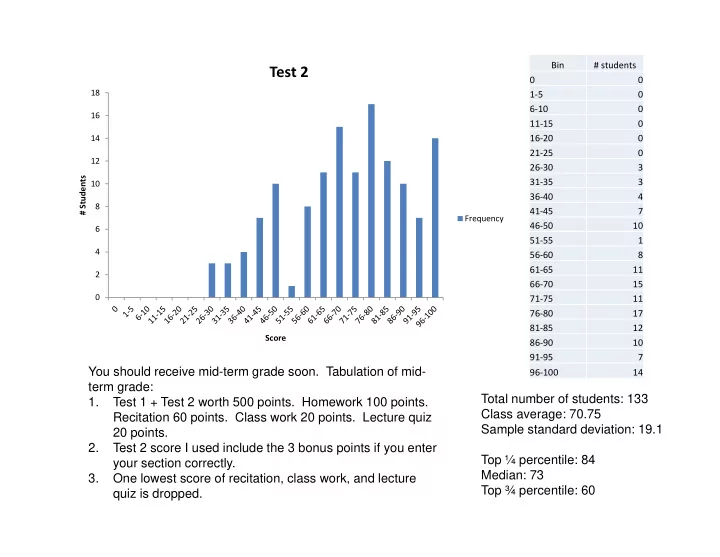

Bin # students Test 2 0 0 18 1 ‐ 5 0 6 ‐ 10 0 16 11 ‐ 15 0 14 16 ‐ 20 0 21 ‐ 25 0 12 26 ‐ 30 3 # Students 31 ‐ 35 3 10 36 ‐ 40 4 8 41 ‐ 45 7 Frequency 46 ‐ 50 10 6 51 ‐ 55 1 4 56 ‐ 60 8 61 ‐ 65 11 2 66 ‐ 70 15 0 71 ‐ 75 11 76 ‐ 80 17 81 ‐ 85 12 Score 86 ‐ 90 10 91 ‐ 95 7 You should receive mid-term grade soon. Tabulation of mid- 96 ‐ 100 14 term grade: Total number of students: 133 1. Test 1 + Test 2 worth 500 points. Homework 100 points. Class average: 70.75 Recitation 60 points. Class work 20 points. Lecture quiz Sample standard deviation: 19.1 20 points. 2. Test 2 score I used include the 3 bonus points if you enter Top ¼ percentile: 84 your section correctly. Median: 73 3. One lowest score of recitation, class work, and lecture Top ¾ percentile: 60 quiz is dropped.
Class 24: Kirchhoff’s Rules
About Kirchhoff’s Rules 1.There are two Kirchhoff rules – Kirchhoff’s current rule (junction rule) and Kirchhoff’s voltage rule (loop rule). 2.More complex circuits cannot be broken down into parallel and series units. The two Kirchhoff’s rules allow us to solve for any circuits, no matter how complex it is (at least theoretically).
Kirchhoff’s Current Rule (Junction Rule) Kirchhoff’s current rule is a result of conservation of charges: At any junction, the sum of currents must equal zero. I 0 junction Junction formed by twisting many wires together.
Kirchhoff’s Voltage Rule Kirchhoff’s voltage rule is a result of conservation of energy: The sum of the potential differences across all elements around any closed circuit loop must be zero. V 0 closed loop Conservation of energy: Work done by battery = Energy stored in conservative elements (e.g. capacitors) + Energy dissipated by resistive elements (e.g. resistors)
Kirchhoff’s Voltage Rule – sign convention Use only currents as unknown variables. V can always be written in 1. terms of currents or derivatives or integrals of currents. 2. Assign current direction to every path in a circuit. Apply Kirchhoff’s current rule as much as you can to reduced the number of unknown variables. 3. Across every component in the circuit determine which end has a higher potential (mark it with a + sign) and which end has a lower potential (mark it with a - sign). This will depend on the current direction you assume in step 2. 4. Pick up a loop and travel around it either clockwise or anticlockwise. If you travel from – to + across a component, then V across the component is positive. If you travel from + to – across a component, then V across the component is negative. You can reverse this convention as long as you do it consistently for the whole loop. 5. If you get a negative current, that means the current direction you assume in step 2 is wrong and you should reverse that direction.
Kirchhoff’s Voltage Rule – sign convention Example: C + - I Q + + IR 0 R C - V V - R bat V C As you travel around a loop, if you find yourself moving from + to - , make V across that component negative (C and R in this example).
Strategy in using Kirchhoff’s Rules 1. Go through every junctions in the circuit. Insert current as unknown variables (unless it is given) for every branch forming the junction. You may have to assume current directions. Make use of the Kirchhoff’s Current Rule and try to use as little of variables as possible. 2. Write down Kirchhoff’s Voltage Rules. Choose the loops that can make the solution easier. 3. Solve the simultaneous equations for the answers.
Dependence in Kirchhoff’s Loop Equations You can write down Kirchhoff’s voltage equations for any closed loop you have chosen. However, the Kirchhoff’s voltage equations you have written may be dependent of each other. Example: You can write Kirchhoff’s 3 voltage equations either for loops 1 and 2, or loops 1 and 3, or loops 2 and 3, 2 1 but not 1, 2, and 3 because these three equations are dependent of each other.
Kirchhoff’s Voltage Rule – Example I 1 I I 2 I 3 1 2 3 - 4RI RI Loop 1: 2 1 Loop 2: 0 - 3RI 4 RI 3 2 Loop 3: 2 - 2RI RI 1
Recommend
More recommend